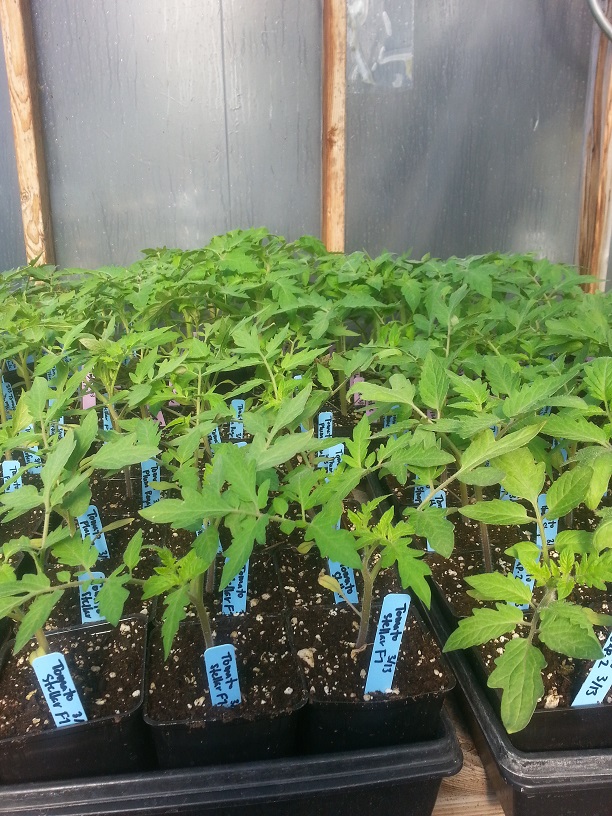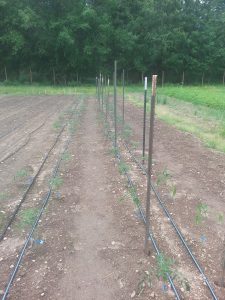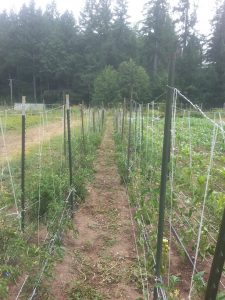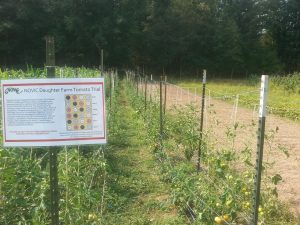Spring Quarter-Trial Seedlings and Late Blight
The trial plants were seeded March 13, 2017, and besides a few potting ups, they required relatively little attention throughout the spring. Luckily, the farm is always filled with helpful Greeners! Meghan O. was interested in helping document the start of this trial by posting some of my e-mails and plant photos as spring quarter went on. You can find her blog here: Meghan’s ComAlt Field Study. Thanks, Meghan!
I used most of the quarter to plan the field layout (which proved more complicated than I originally anticipated), and also to investigate plant pathology, specifically late blight in tomato. Both my final paper and a bibliography of useful resources can be found on this blog.
Trial Design
A randomized complete block design divides the field into equal-sized blocks, which can be thought of as replicates. Within each block, each treatment (or in our case variety) is randomly placed one time. As a daughter trial, we were only responsible for doing a single replicate of 11 varieties with 8 plants each. But in my endeavor to run statistical tests with data from the trial, I chose to do 3 blocks with 3 plants of each variety within each block. I also made sure to buffer the edges with extra plants for the farm’s market stand. The edge effect has proven significant, so data should not be collected from these plants (unless of course your hypothesis involves the edge effect).
To further complicate the matter, Evergreen’s Organic Farm only had so much field space they could sacrifice. At the end of the day, I needed to fit the trial into two 100 ft. x 30 in. beds. It meant deviating from the mother trial spacing (with OSU’s permission, of course), but things managed to come together. One of many wonderful things about NOVIC daughter trials is that growers and farms are encouraged to grow crops the way they normally would rather than prescribing to a particular protocol. After all, organic systems are so diverse that few farms do things exactly the same.
The photo above is from June 13, 2017. You can see 2 beds, each with 2 lines of drip irrigation. In order to fit all the plants for 3 blocks instead of 1, we had to plant double-rows on a staggered spacing. We used measuring tapes and planting sticks to help keep things as planned. When all was said and done, each bed also had two rows of T-posts with top wires for trellising the indeterminate types.
When the sun and heat finally graced us in July (!!) the tomatoes took off. Below is a photo from July 20th, which also happens to be my birthday. Hopefully this better illustrates the in-field spacing. As well, you can see the two-leader method the farm uses for their indeterminate types. Since this trial intermixes determinate and indeterminate (something I wouldn’t recommend after the fact), we wove lines of trellis (like the Florida Weave) down the whole row.
Whether the extended wet season or the varieties themselves, ripe fruit proved elusive until late July. Most varieties threw their first ripe fruit in August. (I’m reminded again of how long we wait for ripe tomatoes here in the maritime northwest.) The last photo is from August 8th, and perhaps little orange and red fruits can be spotted if you look close enough. To discourage picking that might skew data, and inform visitors of the project, a sign was made and placed in the field.
Be sure to check my posts for updates of how harvests are going (or went)!



